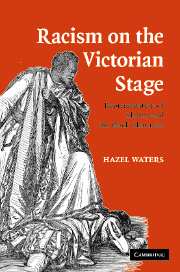Book contents
- Frontmatter
- Contents
- List of illustrations
- Acknowledgements
- Introduction
- 1 From vengeance to sentiment
- 2 The beginning of the end for the black avenger
- 3 Ira Aldridge and the battlefield of race
- 4 The comic and the grotesque: the American influence
- 5 The consolidation of the black grotesque
- 6 Slavery freed from the constraint of blackness
- 7 Uncle Tom – moral high ground or low comedy?
- Afterword
- Notes
- Bibliography
- Index
5 - The consolidation of the black grotesque
Published online by Cambridge University Press: 22 September 2009
- Frontmatter
- Contents
- List of illustrations
- Acknowledgements
- Introduction
- 1 From vengeance to sentiment
- 2 The beginning of the end for the black avenger
- 3 Ira Aldridge and the battlefield of race
- 4 The comic and the grotesque: the American influence
- 5 The consolidation of the black grotesque
- 6 Slavery freed from the constraint of blackness
- 7 Uncle Tom – moral high ground or low comedy?
- Afterword
- Notes
- Bibliography
- Index
Summary
By the late 1830s, popular racial commentary on the character and abilities of the black had undergone a major shift in tone; a shift that had long been prepared for through the medium of comedy, Charles Mathews's ‘black fun’. It may seem somewhat arbitrary to distinguish between the impact of T. D. Rice in the late 1830s and the further development, in the 1840s, of the type of black image he popularised, but it is, I think, necessary for an understanding of how the black stereotype developed. Rice's conception of the black may have been some distance from reality, but those that followed were even more remote and more pernicious. Overall, one can trace in the England of the 1840s a greater expansion of the notion of the grotesqueness of the black figure. Expansion is the right word, for this image oozed out of minstrelsy to fill almost every gap in which the black dramatic character functioned. This was especially so in relation to the black woman, who now came under attack for her bizarre mimicry of every quality that defined proper womanhood.
Rice himself made his last appearance in England at the Adelphi in Edward Stirling's Yankee Notes for English Circulation, which was set in a New York hotel, à la Charles Mathews. Dickens's account of his travels in America, American Notes, had appeared some three months before, but though Stirling's title seems to attempt to capitalise on this, there is no echo of American Notes except in the drinks that are called for (mint julep, cobblers sherry, gin sling) and a speech at the end where the Rice character, Julius Caesar Washington Hickory Dick, threatens, ‘'Em go upon a grand tower to England, make a book maself, and tell about de white trash in dis country like Massa Boz and Missee Trollops.’
- Type
- Chapter
- Information
- Racism on the Victorian StageRepresentation of Slavery and the Black Character, pp. 114 - 129Publisher: Cambridge University PressPrint publication year: 2007



